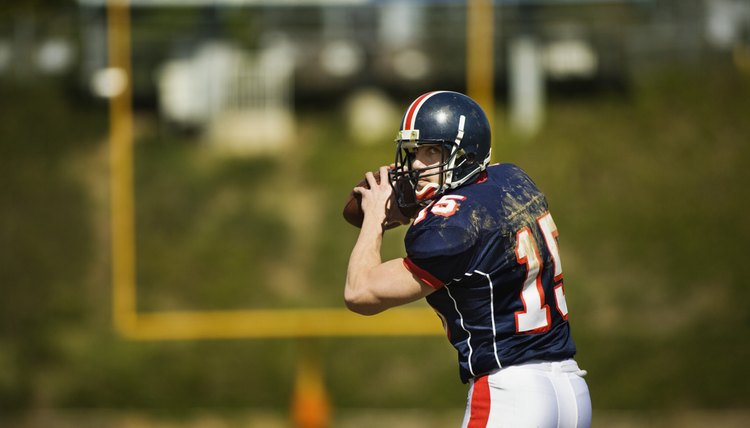Elbow Pain When Throwing a Football

Elbow pain when throwing a football is often simply diagnosed as elbow tendinitis. However, there are different types of elbow tendinitis. Pain that occurs when throwing a football is called "thrower's elbow." Whereas most forms of tendinitis only affect one side of the elbow, thrower's elbow -- common in football players -- affects both sides of the elbow.
Thrower's Elbow
Thrower's elbow affects both the medial and the lateral sides of the elbow. Pain on the medial, or inside of the elbow is commonly called golfer's elbow while pain on the lateral, or outside of the elbow is commonly called tennis elbow. Elbow tendinitis that affects football throwers inflames the tendon's connections between the pronator teres muscle, the extensor carpi radialis brevis muscle and their corresponding bone joints: the medial epicondyle and the lateral epicondyle.
Causes
The most basic and frequent cause of thrower's elbow tendinitis is overuse. When you throw a football, your arm is moving at a rapid rate that puts stress on your elbow. As your arm comes around your body, the inside, or medial, tendons stretch to maximum capacity. At the same time, the outside, or lateral tendons are compressed. Tendons are responsible for holding muscles to bones at certain distances. Tendons have some elasticity, but stretching them greatly can have adverse affects. Likewise, compressing them puts unnecessary pressure on the bones. Over time, this stretching and comression wears down the tendon's connections. The problem is made worse when players throw without warming up because the tendons are stiff and inflexible.
Treatment and Symptoms
Symptoms include pain, swelling and stiffness when throwing the football. Thrower's elbow in football players is treated either with or without surgery. Surgery repairs more severe cases of tendinitis; most cases will require non-operative procedures. These treatments are meant to reduce inflammation, regain strength and increase flexibility. Treatments can include wrist and elbow stretching exercises, massage therapy, application of heat and ice and light strengthening exercises. Treatment also includes avoiding any activities that exacerbate the pain or inflammation.
Prevention Practices
The best way to avoid elbow tendinitis is with proper warm-up and stretching routines prior to throwing footballs at full speed. Gradually warming up the tendons with gentle throwing sessions loosens them and allows them to stretch naturally, reducing strain when throwing at full speed. After warming up the elbow, engage in a series of thorough stretches of the elbow, wrist and shoulder. When player's are not throwing, steps should be taken to keep elbow's warm with a jacket or blanket. Coaches and parents should instill these practices into young players when they start playing football to develop good habits.
References
- Vaquero-picado A, Barco R, Antuña SA. Lateral epicondylitis of the elbow. EFORT Open Rev. 2016;1(11):391-397. doi:10.1302/2058-5241.1.000049
- Amin NH, Kumar NS, Schickendantz MS. Medial epicondylitis: evaluation and management. J Am Acad Orthop Surg. 2015;23(6):348-55. doi:10.5435/JAAOS-D-14-00145
- Blackwell JR, Hay BA, Bolt AM, Hay SM. Olecranon bursitis: a systematic overview. Shoulder Elbow. 2014;6(3):182-90. doi:10.1177/1758573214532787
- Truong J, Ashurst JV. Septic Bursitis. Treasure Island, Fl: StatPearls Publishing; 2019.
- Varacallo M, Mair SD. Proximal Biceps Tendinitis and Tendinopathy. Treasure Island, Fl: StatPearls Publishing; 2019.
- Bellapianta JM, Lavelle WF, Lavelle ED, Onyedika I, Economedes D, Whipple R. Hand Pain. Current Therapy in Pain. 2009:156-167. doi:10.1016/b978-1-4160-4836-7.00021-3
- Moradi A, Ebrahimzadeh MH, Jupiter JB. Radial Tunnel Syndrome, Diagnostic and Treatment Dilemma. Arch Bone Jt Surg. 2015;3(3):156-62.
- Saeed W, Waseem M. Elbow Fractures Overview. Treasure Island, Fl: StatPearls Publishing; 2019.
- Athwal GS. Elbow Dislocation - OrthoInfo - AAOS. OrthoInfo: American Academy of Orthopaedic Surgeons. Oct 2017.
- Bursitis. MedlinePlus. Sept 12, 2019.
- Harvard Health Publishing. The importance of stretching. Harvard Health. Sept 2013.
- Tennis Elbow (Lateral Epicondylitis) - OrthoInfo - AAOS. OrthoInfo: American Academy of Orthopaedic Surgeons. Jul 2015.
- Shah CM, Calfee RP, Gelberman RH, Goldfarb CA. Outcomes of rigid night splinting and activity modification in the treatment of cubital tunnel syndrome. J Hand Surg Am. 2013;38(6):1125-1130.e1. doi:10.1016/j.jhsa.2013.02.039
- Biceps Tendinitis - OrthoInfo - AAOS. OrthoInfo: American Academy of Orthopaedic Surgeons. Feb 2016.
- Kinaci A, Neuhaus V, Ring D. Surgical procedures of the elbow: a nationwide cross-sectional observational study in the United States. Arch Bone Jt Surg. 2015;3(1):13-8.
- American Academy of Orthopedic Surgeons. (n.d.). Elbow Arthroscopy.
- Kane SF. Evaluation of Elbow Pain in Adults. Am Fam Physician. 2014 Apr 15;89(8):649-57.
- O'Connor FG. (2018). Evaluation of elbow pain in adults. Fields KB, ed. UpToDate. Waltham, MA: UpToDate Inc.
- Sources:American Academy of Orthopedic Surgeons (n.d.). Elbow Fractures in Children.
Writer Bio
Patrick Hutchison has been doing freelance work since 2008. He has worked as a physical therapy aide and as a writer for various websites including Destination Guides and several travel-related companies. Hutchison has a Bachelor of Arts in history and anthropology from the University of Washington.
